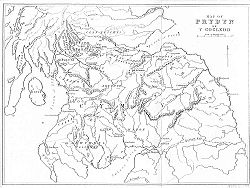| Revision as of 19:27, 23 June 2009 editAlexbot (talk | contribs)196,144 editsm robot Adding: es:Gododdin← Previous edit | Revision as of 02:30, 25 June 2009 edit undoKwamikagami (talk | contribs)Autopatrolled, Extended confirmed users, Template editors475,957 editsm fix IPA link using AWBNext edit → | ||
| Line 1: | Line 1: | ||
| ] | ] | ||
| The '''Gododdin''' ({{ |
The '''Gododdin''' ({{IPA-cy|goˈdoðin}}) were a ] people of north-eastern ] (modern north-east ] and south-east ]) in the ] period, the area known as the ] or Old North. They are best known as the subject of the 6th-century ] poem '']'', attributed to ]. | ||
| The name ''Gododdin'' is the ] form; it is derived, via ] ''Guotodin'' from the ] word '']'', attested in ] texts.<ref>], "'']''" (ca. ])</ref> | The name ''Gododdin'' is the ] form; it is derived, via ] ''Guotodin'' from the ] word '']'', attested in ] texts.<ref>], "'']''" (ca. ])</ref> | ||
Revision as of 02:30, 25 June 2009

The Gododdin (Template:IPA-cy) were a Brittonic people of north-eastern Britain (modern north-east England and south-east Scotland) in the sub-Roman period, the area known as the Hen Ogledd or Old North. They are best known as the subject of the 6th-century Welsh poem Y Gododdin, attributed to Aneirin.
The name Gododdin is the Modern Welsh form; it is derived, via Old Welsh Guotodin from the Brythonic language word Votadini, attested in Latin texts.
Kingdom
It is not known exactly how far the kingdom of the Gododdin extended, possibly from the Stirling area to the kingdom of Bryneich (Bernicia), and including what are now the Lothian and Borders regions of eastern Scotland. It was bounded on the west by the Brythonic Kingdom of Strathclyde, and to the north by the Picts. Those living around Clackmannanshire were known as the Manaw Gododdin. According to tradition, local kings of this period lived at both Traprain Law and Din Eidyn (Edinburgh, still known as Dùn Éideann in Scottish Gaelic), and probably also at Din Baer (Dunbar).
In the wake of Roman withdrawal around 410, Coel Hen (Old King Cole), who Morris suggests may have been the last of the Roman Duces Brittanniarum (Dukes of the Brythons), seems to have taken over the northern capital at Eburacum (York) and became something akin to a High King of Northern Britain ("Britain" in this context excludes the lands of the Picts), ruling over what had been the northern provinces, possibly including the lands of the Votadini. This area became known in later poetry as the Hen Ogledd. After his death the North probably began to divide. By about 470 most of the Votadini's lands became the kingdom of Gododdin, while the southern part of their territory between the Tweed and the Tees (approximately modern Northumberland and County Durham) seems to have become a separate kingdom then called Bryneich.
Kings of Gododdin
David Nash Ford identifies the Kings of the Gododdin with those of Lothian and suggests they are recorded in 'Pedigree 16' of Harleian MS 3859. King Leudonus, after whom Lothian is named, is remembered in the local legend of St. Kentigern (alias Saint Mungo). Cunedda, legendary founder of the Kingdom of Gwynedd in north Wales, is supposed to have been a Manaw Gododdin warlord who migrated south-west about this time.
Later history
In the 6th century, Bryneich was invaded by the Angles and became known as Bernicia. The Angles continued to press north. In around. 600 about 300 men of the Gododdin fell in the battle of Catraeth (almost certainly Catterick in North Yorkshire), as recorded in Aneirin's poem-cycle Y Gododdin.
In 638 Din Eidyn (Edinburgh) was under siege and may have fallen to the Angles, for the Gododdin seem to have come under the rule of Bernicia around this time. To what extent the native population was replaced or assimilated is unknown. Bernicia became part of Northumbria, and by 954 was overrun by the Danish kingdom of Jorvik (York). Shortly afterwards this came under a unified England, then in 1018 Malcolm II brought the region as far as the River Tweed under Scottish rule.
See also
Notes
- Claudius Ptolemaeus, "Geographia" (ca. 2nd century CE)
- Watson, 1926
- Jackson, 1969
- Nennius, Historia Britonum, http://www.fordham.edu/halsall/basis/nennius-full.html, retrieved 04/04/09.
References
- Ian Armit (1998). Scotland's Hidden History (Tempus ) ISBN 0-7486-6067-4
- Kenneth H. Jackson (1969). The Gododdin: The Oldest Scottish poem (Edinburgh: University Press)
- John Morris (1973). The Age of Arthur (London: Weidenfeld & Nicolson) ISBN 0-297-17601-3
- Stuart Piggott (1982). Scotland Before History (Edinburgh: University Press) ISBN 0-85224-348-0
- W.J. Watson (1926, 1986). The History of the Celtic Place-Names of Scotland: being the Rhind lectures on archaeology (expanded) delivered in 1916. (Edinburgh, London: W. Blackwood & Sons, 1926; Edinburgh: Birlinn, 1986, reprint edition). ISBN 1-874744-06-8
External links
- Skene, William Forbes (1869), The Gododdin Poems, Forgotten Books (published 2007), ISBN 1605061670, retrieved 2008-08-09
- Ancient Lothian - Histories - Celtic Gododdin
- Early British Kingdoms: Royal Biographies
- The History Files: Post-Roman Celtic Kingdoms - Goutodin
- The History Files: The Kings of Northern Britain
- Scotland
| Hen Ogledd | |
|---|---|
| Kingdoms or Territories | |
| Important Places | |
| People | |